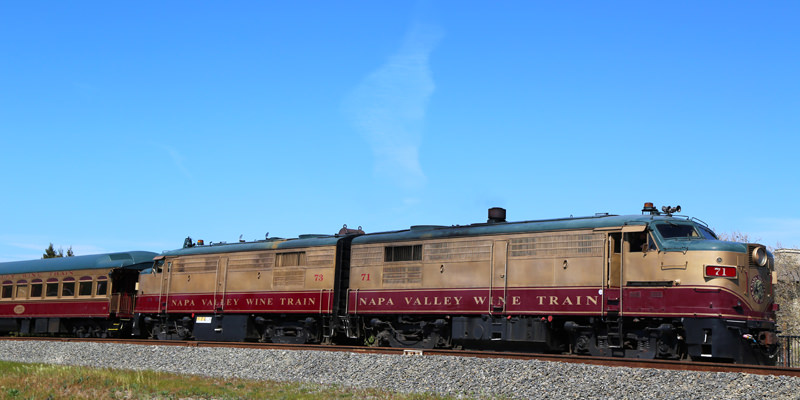When it comes to learning about wine, it’s the amount of minutiae that sucks out all the fun. Regions, subregions, crus, vineyards, producers, grapes — it can make our favorite beverage downright impossible to understand. In the grand scheme of things, the wines of the Napa Valley seem fairly straightforward; the region is all about rich, buttery Chardonnay and oaky, powerful Cabernet Sauvignon, right? But there’s more to Napa than meets the eye.
Sommelier and writer Kelli White thought she knew what Napa was about when she decided to leave the New York wine scene and relocate to the Napa Valley. But while she and her fiancé Scott Brenner were developing the all-Napa wine program at PRESS in St. Helena, featuring vintages dating back to the 1940s, White quickly discovered that this was not the case. She was most surprised by how well the wines aged. “Seriously, I did not expect it,” she says. “I knew that [a few] could age, but I was surprised at how well so many of the older wines were drinking, even from so-called minor producers.” She also emphasizes the diversity of Napa’s wines, even within the spectrum of Cabernet Sauvignon, noting that some back-vintages of Napa Cab will satisfy devotees of traditional Barolo.
However, as White began to explore Napa and the many producers on the list at PRESS, she realized that much of Napa’s history was largely unknown. Many major proprietors, in fact, had an unclear history of their own wineries and vineyards! So, White set out to write the book that she wished had existed on the Napa Valley’s history, producers, and wines, traveling many times from winery to winery, cellar to cellar, to uncover the facts and produce tasting notes. Four and a half years and a massive 1,200 pages later, Napa Valley: Then and Now is one of the most comprehensive looks at Napa beyond the misconceptions.
For those who don’t have a coffee table large enough to hold White’s book, we unearthed five things you probably don’t know about Napa wine during a recent seminar with White. But these five facts are only the tip of the iceberg when it comes to California’s most famed wine region. Get ready to dive in!
Many of the founding vineyards of the Napa Valley were planted with Riesling.
Thanks to the California Gold Rush in the mid-1800s, many Europeans, particularly Germans, made their way west in pursuit of fortune. Unfortunately, by the time they arrived, much of the gold was gone. So some of these immigrants, hearing that the Napa Valley’s landscape and soils mimicked those of their home vineyards, started planting grapes, including Charles Krug (of his namesake winery), Jacob Schram (of Schramsberg), and Jacob Beringer (of Beringer). Thus, along with Zinfandel and imitations of famed European wines, many of these early vineyards were in fact planted with German varieties like Riesling, and some wineries still produce Riesling today.
The Napa wine business in the 1800s was booming!
By the 1880s, the wine business in the Napa Valley was thriving, with around 140 wineries (some of very large size) established and over 20,000 acres under vine. “I was amazed to read reports of how successful the industry was in the 1880s and 1890s,” White notes. “The number of wineries … and the area under vine seemed impossible to me.” But by the 1890s, those vineyards were whittled down to a mere 3,000 acres due to the devastating vineyard pest phylloxera. That, combined with Prohibition and the Great Depression that followed, hurt the the Napa wine industry for decades. “The industry would take until the 1980s (100 years!) to see those numbers again,” White says.
Cabernet Sauvignon was not the most planted grape in Napa until 1991.
Today, the top grape associated with Napa is Cabernet Sauvignon, but it’s only in the past 25 years that Cab has dominated vineyard plantings. As the industry in Napa began to rebuild in the 1950s and 60s, many Napa vintners planted grapes on a UC Davis-recommended rootstock called AxR-1. Unfortunately, despite the university’s claims, this rootstock was not resistant to phylloxera, and an entirely new phylloxera epidemic swept through the Valley’s vineyards in the 1980s. This created the need for massive vineyard replantings, and many winemakers chose to devote more land to a grape that was gaining wide international recognition: Cabernet Sauvignon. So which grape previously held the No. 1 spot? Chardonnay!
Alcohol percentages of old Napa wines were much lower.
It’s no surprise that a Napa Cabernet Sauvignon from the 1960s or 70s would taste quite different from a current-release bottle, but the reason is not simply because the bottle is a half-century old. Wines from these decades tend to be less ripe, more delicate, and significantly lower in alcohol. Most Cabernet Sauvignons from the 60s hover around 12% or 12.5% ABV. This is both because Napa vineyards tended to have a lot of viruses prior to the 1980s, some of which would delay ripening, and because the mindset of winemakers was different. “The way of thinking used to be that overripe grapes were undesirable,” White notes. “More than one winery would turn fruit away if it measured more than 24 Brix at the crush pad.” In layman’s term’s, 24 Brix can be anywhere from 13.5% to 14.5% alcohol. By contrast, it’s not uncommon today to find Napa Cabs measuring 15% ABV or more.
You can’t always trust the labels of old wines.
While White acknowledges that ABVs of older Napa wines were lower, she also warns that old labels cannot be blindly trusted: “I asked one old-timer about the low alcohol in his 1960s and 70s wines ” she says. “They all listed 12.5%. He basically said, ‘Yeah, I have no idea what those alcohols were. We just reprinted the same label every year!’”

